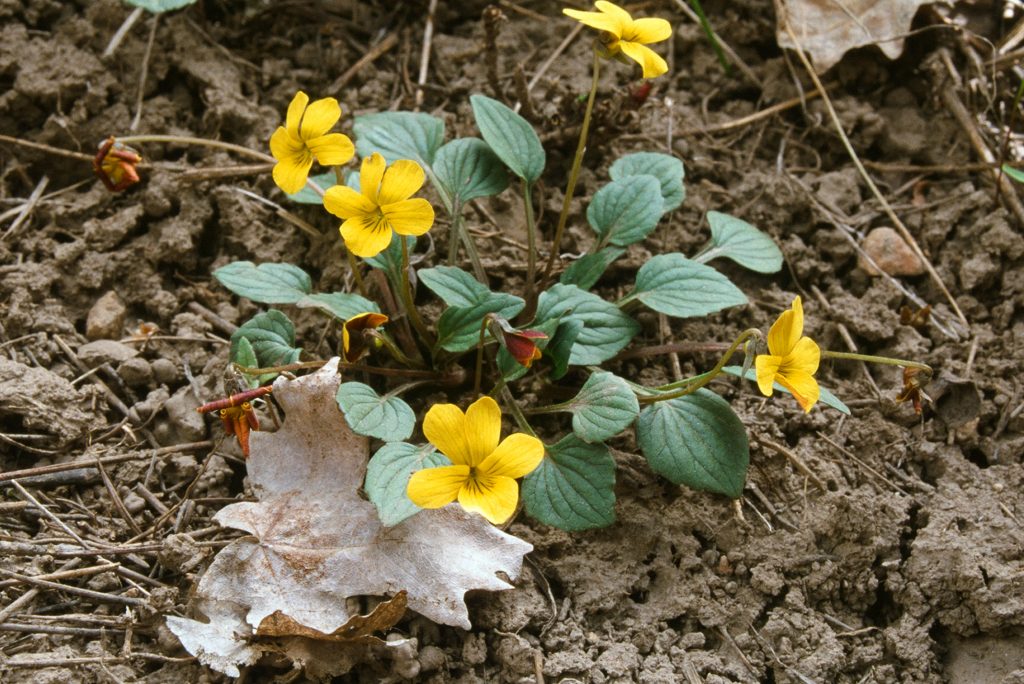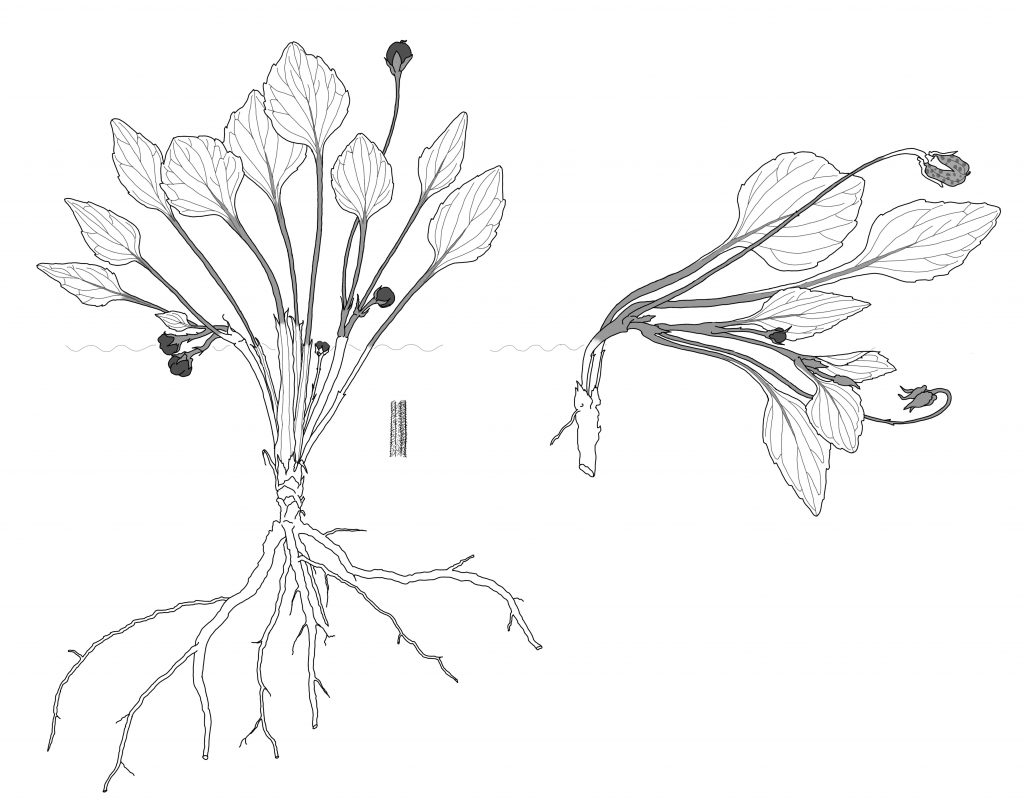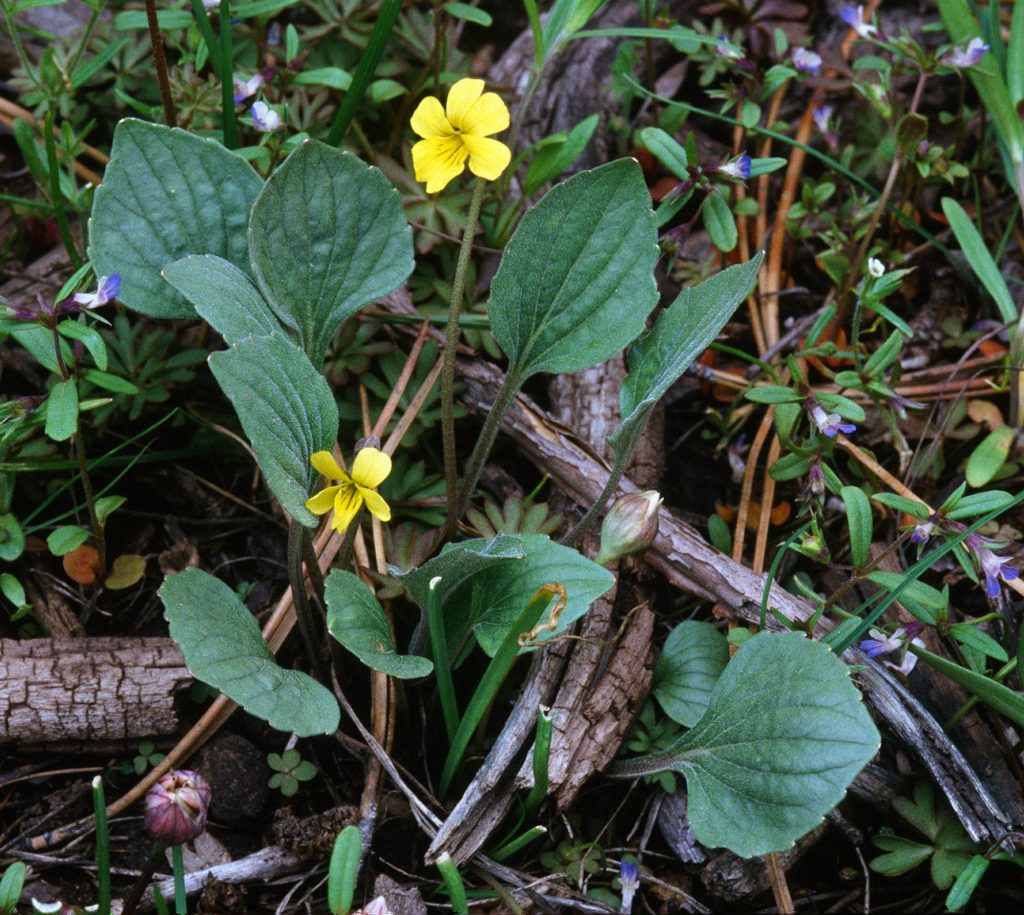Viola utahensis MS Baker & JC Clausen.
Description. Illustrations: 2 photographs of Viola utahensis and 1 drawing.
Leafl. W. Bot. 5: 145. 1949.
Isotype CAS, collected 8 May 1937, B. Maguire 16026.
Sect. Chamaemelanium subsect. Nuttallianae [Marcussen, 2011].
V. utahensis has no hairs on the inside of the lateral petals, also attenuate bases to leaves. See key to violets in Holmgren’s Flora of the Great Basin.

deep soils in sagebrush. Moffat County on north base of Douglas Mt. out of Greystone, CO.
Bill Weber sent me to NW corner of Colorado, to Mt. Douglas, to find V. utahensis in its most easterly site. The locality called Dutch Oven Spring, from Greystone you follow the road that will go up onto Douglas Mountain. That is, from the store you go more or less south (following the road to the left from the store). Then you reach a fork and take the right hand fork. The road climbs gently and goes across a cattle guard I believe and you come to a rock flat (with Fritillaria pudica and Lewisia rediviva) on your left. The road forks again; you take the right fork that goes toward Zenobia Peak Lookout. This road might be very muddy right now and you might have trouble going very far on it. But on your left there will be a wooden gate beyond which there is a low ranch house and garage. This is Whisky Springs. Now, Dutch Oven Spring is across the road and below Whisky Springs gate; you sort of follow the drainage down to your right and you will reach some rocky and soggy ground. This is Dutch Oven Spring, and the Viola utahensis should be between the road and the wet area, also hardly more than a hundred yards or so, [approximately 7,650 ft]. I should think that walking around the area there should be many places where it occurs. The date of my collection was May 1, but the season is so late that you still should find it when you return to Greystone.

Annual average rainfall below 10 inches.
Top of Douglas Mountain is Permian or Tertiary sediments above the salmon-colored Weber Sandstone of the Yampa Plateau. Douglas Mountain runs east-west, north of the Yampa River and east of the [north flowing] Green River in the Dinosaur National Monument. Douglas Mountain is the eastern part of the Uinta Mountains, the only mountain range to run in an east-west direction in Colorado. Most of the Uinta range is to the west in Utah. Viola utahensis has been able to move east along the ridges to this site, the easternmost site of its range, which extends west into Nevada, as was seen on Currant Mountain. Because of the direction of the mountains here, V. utahensis does not occur further south of this site in Colorado. Moffatt Co. Holmgren says it occurs in Routt County.
Weber sandstone though it contains no fossils, is clearly Pennsylvanian and Permian in age because it lies above known Pennsylvanian marine shales and below known Permian and Triassic rocks. Its broad cross bedding shows that parts of it at least are dune deposits; red shales between the dune-like layers suggest pond or inter-dune or lake deposits or possibly deposits on an ancient desert delta.
At the site above Wood Camp, Logan Canyon, Utah, is Viola utahensis, confirmed by the teeth on the margin (not exaggerated and curled as for V. purpurea), growing near V. vallicola, on dolomite or limestone. The plants of V. utahensis are not upright, as the one photographed in NW Colorado.

V. utahensis vs. V. purpurea ssp. venosa
Gerrit Davidse (pp 75 & 78) says stipules of both species are ‘inconspicuous’. Welsh et al, A Utah Flora, says both species the same and (p. 643) says stipules mostly 4-10 mm long, entire or toothed. Neither mention that the stipules are adnate for most of length. Look up original description! ‘The pine violet (V. purpurea) forms an intergrading series with V. nutallii, a portion of that variation forms the basis for recognition of V. utahensis, but most specimens can be assigned readily to one or other of the species.’ (ie, V. purpurea ssp. venosa). Davidse says, quoting Clausen (p.3) that the V. purpurea species complex was an example of ecologic-genetic speciation, while the V. nutallii Pursch. species complex was characterised as one differentiated by polyploidy. Does this mean that all the purpurea species have the same chromosome number (see p. 2, No). Brainerd does not mention V. utahensis. Description of V. purpurea ssp. venosa with purple pods, brown seeds. For V. nutallii, pods green, seeds pale brown.
growing the mouth of Wellsville Mountains, in Cache County, Utah.
Photographer: Gerrit Davidse
Copyright: MBG
Voucher: Davidse 1016
Tropicos Images, MBG: mobot.mobot.org/W3T/Search/image/iix198.html
Viola utahensis M.S. Baker & J.C. Clausen X beckwithii Photo of the hybrid between V. utahensis and V. beckwithii from west of Wellsville, Cache County, Utah. For photos see i-photo file.
Photographer: Gerrit Davidse
Copyright: Gerrit Davidse, 1998 for MBG.
mobot.mobot.org/W3T/Search/image/iix198.html
Stunning photo of flower, very with large yellow eye on base of all petals but mostly on the lowest petal. The two top petals are mid-pink (but taken in full sun, so is probably mid-purple, i.e. more blue and less red) but colour is uneven in density, sometimes paler, with a few patches of the dark velvet purple-black usual to V. beckwithii. The lateral petals are streaked with the same mid-pink or purple colour of the top petals, on a white background. The lowest petal has a yellow eye with black-purple striae. Outside the yellow is mainly white, but in the middle is an area of pink/purple splashes. Leaves are irregularly lobed, part way between those of each parent.
Smithsonian herbarium has type specimen:
Viola utahensis Baker, M.S. & Clausen, J.C., Leafl. W. Bot. 5:145. 1949 – Isotype (Violaceae)
COLLECTION: Maguire, B. 16025, 01 May 1937. USA. Utah. Cache. Logan, mouth of Providence Canyon.
2n=4x=24.
Photographer: Gerrit Davidse
Viola utahensis M.S. Baker & J.C. Clausen X beckwithii Torr. & A. Gray
Det by – G. Davidse, 1967
Previous determinations:
Viola beckwithii Torr. & A. Gray X utahensis M.S. Baker & J.C. Clausen
Det by: Gerrit Davidse, 1967
Date changed – 28 Aug 2002
Collection Information: United States, Utah, Cache, Vicinity: , Elevation: 4800 f
Collector(s): Gerrit Davidse, Collection date: 26 April 1967
Herbaria: MO, UTC
Specimen data: At least 10 separate plants growing in 6″x6″ area. This might indicate some seed production. N=12. Meiosis very irregular